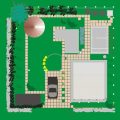1. Understanding Task Lighting: Purpose and Benefits
When it comes to creating a comfortable and functional home, lighting plays a major role—especially in areas where you need to focus. That’s where task lighting comes in. Unlike ambient or accent lighting, task lighting is all about providing the right amount of light exactly where you need it for specific tasks like reading, cooking, writing, or working on your computer.
What Is Task Lighting?
Task lighting refers to focused lighting that helps you perform daily activities more efficiently. Think of it as your personal spotlight—it cuts down on eye strain and improves visibility for precision tasks. Whether youre chopping vegetables in the kitchen or typing up emails in your home office, good task lighting makes a noticeable difference.
How Task Lighting Differs from Other Types of Lighting
To better understand where task lighting fits into your home setup, here’s a quick comparison with other common types of lighting:
| Lighting Type | Main Function | Common Locations |
|---|---|---|
| Ambient Lighting | Provides overall illumination for a space | Living rooms, bedrooms, hallways |
| Accent Lighting | Adds drama and highlights decorative elements | Artwork displays, shelves, architectural features |
| Task Lighting | Focused light for specific tasks and activities | Kitchens, home offices, reading nooks |
Why Task Lighting Is Essential in U.S. Homes
In American homes, kitchens and home offices are some of the busiest spaces—and they require proper lighting to be truly functional. With more people working remotely and spending time preparing meals at home, effective task lighting has become more important than ever. Heres why its a must-have:
- Reduces Eye Strain: Especially when reading or working at a screen for long hours.
- Improves Accuracy: Better visibility means fewer mistakes when following recipes or filling out paperwork.
- Saves Energy: You can use task lights without needing to brighten the whole room.
- Adds Style: From sleek under-cabinet lights to modern desk lamps, task lighting can enhance your décor too.
Popular Task Lighting Options in the U.S.
The most common choices for task lighting in American households include:
- Under-cabinet lights: Perfect for illuminating countertops while cooking.
- Adjustable desk lamps: Ideal for focused work in a home office or study area.
- Pendant lights: Often used over kitchen islands or dining tables for targeted brightness.
- Sconces: Mounted on walls near beds or reading chairs for convenience and style.
No matter the room or activity, adding dedicated task lighting can make your daily routine easier and more enjoyable. It’s not just about brightness—it’s about making light work smarter for your needs.
2. Popular Types of Task Lighting Fixtures
When it comes to task lighting in American homes, functionality meets style. Whether youre prepping dinner or working from home, having the right lighting fixture can make all the difference. Here are some of the most popular task lighting options commonly used in U.S. kitchens and home offices:
Under-Cabinet Lights
Perfect for kitchens, under-cabinet lights illuminate countertops directly beneath wall-mounted cabinets. This type of lighting reduces shadows and provides focused light exactly where you need it—like when chopping vegetables or reading a recipe.
Why Homeowners Love Them:
- Discreet Design: Easily hidden under cabinets for a clean look.
- Even Illumination: Helps reduce eye strain by eliminating dark spots.
- Energy Efficient: Most models use LED bulbs that last for years.
LED Desk Lamps
A favorite in home offices, LED desk lamps offer adjustable brightness and directional lighting. Theyre ideal for reading documents, typing on a keyboard, or doing detailed work like crafting or drawing.
Why Homeowners Love Them:
- Flexible Positioning: Many models have swivel heads and adjustable arms.
- Modern Look: Sleek designs fit well with contemporary office décor.
- Low Heat Emission: LEDs stay cool even after hours of use.
Pendant Lights
Pendant lights are not only stylish but also highly functional. Hung from the ceiling, these fixtures provide focused illumination over kitchen islands, desks, or dining tables.
Why Homeowners Love Them:
- Design Variety: Available in countless shapes, sizes, and finishes to match any interior style.
- Zoned Lighting: Great for defining specific work areas in open-concept spaces.
- Dimmable Options: Many models come with dimming features to adjust brightness as needed.
Quick Comparison Table
| Lighting Type | Best For | Main Benefits |
|---|---|---|
| Under-Cabinet Lights | Kitchens | Sleek design, even countertop lighting, energy efficient |
| LED Desk Lamps | Home Offices | Adjustable positioning, modern look, low heat output |
| Pendant Lights | Kitchens & Workspaces | Aesthetic appeal, zoned lighting, dimmable options |
Selecting the right task lighting fixture depends on your space and daily needs. From sleek under-cabinet strips to adjustable desk lamps and statement pendant lights, each option offers unique benefits that enhance both function and style in your home.
![]()
3. Home Office Task Lighting Strategies
Creating a productive and comfortable home office starts with good task lighting. Whether youre on Zoom calls, writing reports, or reading documents, the right lighting setup can make a big difference in your focus and eye comfort.
Choose the Right Type of Bulb
The type of bulb you use affects both the quality of light and your energy efficiency. Here’s a quick guide:
| Bulb Type | Best For | Color Temperature |
|---|---|---|
| LED | Energy-efficient, long-lasting, low heat | 4000K–5000K (cool white) |
| Halogen | Crisp light for detailed tasks | 3000K–3500K (neutral white) |
| Fluorescent | Budget-friendly but less popular due to flicker | 3500K–4100K |
Proper Light Placement Matters
Avoid harsh overhead lights that cause glare on your screen or shadows on your desk. Instead, use a combination of ambient and task lighting. Desk lamps are ideal for focused work areas. Position your task light so it shines from the opposite side of your dominant hand to avoid casting shadows while writing.
Tips for Ideal Light Placement:
- If youre right-handed, place the lamp on the left side of your desk; if left-handed, place it on the right.
- The bottom of the lampshade should be at eye level when seated to reduce direct glare.
- Aim for layered lighting: combine natural light, ceiling lights, and a dedicated task light.
Reduce Eye Strain During Screen Time
Staring at screens all day can lead to digital eye strain. Good lighting reduces this risk by balancing brightness and contrast around your monitor.
Eye-Friendly Lighting Tips:
- Avoid placing your monitor directly in front of or behind a window to reduce glare.
- Add bias lighting—low-level backlighting behind your monitor—to soften contrast between screen and surroundings.
- Use dimmable LED desk lamps so you can adjust brightness throughout the day.
- Aim for color temperatures between 4000K–5000K for a daylight-like feel that promotes alertness.
A well-lit home office not only supports productivity but also helps prevent headaches and fatigue. With smart choices in bulbs, placement, and brightness, your workspace can be both efficient and easy on the eyes.
4. Kitchen Task Lighting Best Practices
In a busy U.S. kitchen, proper task lighting is essential for safety, precision, and comfort. Whether youre chopping vegetables, boiling pasta, or washing dishes, each work zone needs the right kind of focused light. Heres how to effectively light key areas in your kitchen using practical methods that fit American home designs and lifestyles.
Prep Areas: Bright and Even Lighting
Food preparation zones need bright, shadow-free lighting so you can safely slice, dice, and measure ingredients. Under-cabinet LED strip lights are one of the most popular solutions in American kitchens—they provide direct illumination right onto the countertop without taking up space or creating glare.
Recommended Features:
- Color Temperature: Choose 3000K to 4000K for a neutral white tone that shows food colors accurately.
- Brightness: Aim for 450–800 lumens per foot of counter space.
- Dimmability: Ideal for adjusting levels during different times of day or tasks.
Stove Tops: Heat-Resistant and Focused Light
The cooking zone over your stove requires lighting that can handle heat and steam while giving you a clear view of whats in the pots and pans. Range hoods with built-in LED lights are a common and efficient solution in U.S. homes. They combine ventilation with focused lighting right where you need it most.
Tips:
- Choose range hoods with at least two LED bulbs for even coverage.
- Avoid halogen bulbs—they get too hot and aren’t energy-efficient.
Sinks: Spot Lighting for Clarity
Washing dishes or cleaning produce under dim light is frustrating. A dedicated task light above the sink—such as a recessed ceiling fixture or a directional spotlight—is ideal. Make sure it’s centered directly over the basin to avoid shadows.
Good Sink Lighting Options:
| Lighting Type | Pros | Best For |
|---|---|---|
| Recessed Ceiling Light | Sleek, out of the way | Modern or minimalist kitchens |
| Pendant Light | Adds style & targeted light | Kitchens with open sink areas |
| Adjustable Spotlight | Can be aimed precisely | Sinks near walls or corners |
Under-Cabinet Lighting: A Must-Have Solution
If theres one upgrade every American kitchen should consider, its under-cabinet task lighting. It not only improves functionality but also adds value and appeal to your home. LED puck lights or continuous LED strip lighting are easy to install and available in plug-in or hardwired formats.
Benefits of Under-Cabinet Task Lighting:
- Makes cooking tasks easier and safer
- Adds a modern look to your kitchen
- Improves energy efficiency when replacing overhead-only lighting
5. Energy Efficiency and Smart Lighting Options
When it comes to task lighting in American homes, energy efficiency and smart technology are top priorities. Whether youre setting up a productive home office or a well-lit kitchen workspace, using the right lighting can save you money and make life more convenient.
LED Bulbs: The Go-To Choice
LED (Light Emitting Diode) bulbs have become the standard for task lighting in U.S. households. They use up to 75% less energy than traditional incandescent bulbs and can last over 25 times longer. This makes them an ideal option for areas where lights are used frequently, like desks and kitchen counters.
Benefits of LED Bulbs:
- Lower energy bills
- Longer lifespan (up to 25,000 hours)
- Cooler operation reduces heat output
- Available in a range of color temperatures (warm to cool white)
Dimmers: Customizable Brightness
Dimmers let you adjust light levels based on your needs—bright for focused tasks or softer for relaxing. They also extend bulb life and reduce energy use. Many modern dimmers are compatible with LED lights, making them easy to integrate into your existing setup.
Popular Dimmer Features:
| Feature | Description |
|---|---|
| Slide Dimmers | Manual sliders that control brightness with precision |
| Touch Dimmers | Sleek touch-sensitive controls for modern spaces |
| Smart Dimmers | App-controlled and voice-activated via Alexa or Google Home |
Smart Task Lighting Systems
Smart lighting is rapidly growing in popularity across the U.S., especially in home offices and kitchens. These systems allow you to control lighting through your smartphone or voice commands, offering maximum convenience and customization.
Top Smart Lighting Features:
- Voice Control: Works with Alexa, Google Home, or Apple HomeKit
- Scheduling: Automate lights based on time of day or routines
- Zoning: Control specific areas independently (e.g., under-cabinet lights vs. desk lamp)
- Energy Monitoring: Track usage and optimize settings for savings
Whether youre chopping veggies or finishing a report, combining energy-efficient LEDs with dimmers and smart controls gives you the perfect balance of function, comfort, and savings—all tailored to fit the modern American lifestyle.


